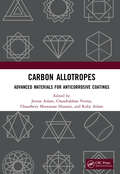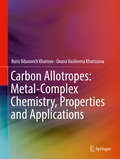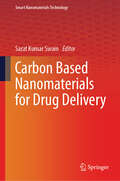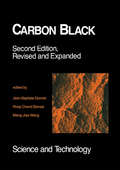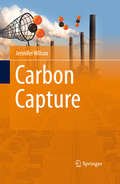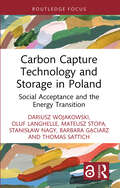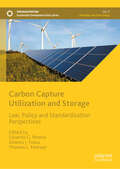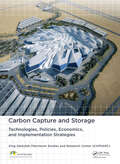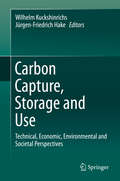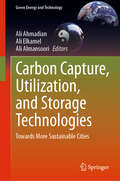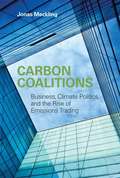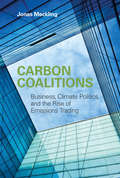- Table View
- List View
Carbon Allotropes: Advanced Materials for Anticorrosive Coatings
by Chaudhery Mustansar Hussain Chandrabhan Verma Jeenat Aslam Ruby AslamThe study of corrosion-resistant coatings using nanostructured materials is developing and growing at a very rapid rate. Carbon Allotropes: Advanced Anticorrosive Coatings Materials summarizes current research and technology on the significance of carbon allotropes in anticorrosive coatings. The book describes the synthesis, characterization, inhibitory mechanism, and industrial applications of carbon allotropes as a corrosion-resistant coating. The usage of carbon allotropes as nanostructure materials based on corrosion-resistant coatings used in contemporary industrial platforms is discussed in this book. Additionally, this book assesses the potential of carbon allotropes as the foundation for corrosion-resistant nanostructure materials and coatings. For scientists and engineers looking for cutting-edge ideas for nanostructures based on carbon allotropes as corrosion-resistant coating materials, this book is an invaluable resource. Salient Features This book covers nanostructured carbon allotropes as materials for corrosion-resistant coatings. The use of carbon allotropes as anticorrosive has revolutionized modern industrial practices. This offers academics and entrepreneurs an influential foundational, interdisciplinary, and primary literature reading. The most cutting-edge coatings based on carbon allotropes are also highlighted, along with current manufacturing and operating challenges. This maintains ongoing research on corrosion-resistant coatings using nanostructured materials while incorporating fresh advancements across the entire area.
Carbon Allotropes: Metal-Complex Chemistry, Properties and Applications
by Oxana Vasilievna Kharissova Boris Ildusovich KharisovThis book provides a detailed description of metal-complex functionalized carbon allotrope forms, including classic (such as graphite), rare (such as M- or T-carbon), and nanoforms (such as carbon nanotubes, nanodiamonds, etc.). Filling a void in the nanotechnology literature, the book presents chapters generalizing the synthesis, structure, properties, and applications of all known carbon allotropes. Metal-complex composites of carbons are described, along with several examples of their preparation and characterization, soluble metal-complex carbon composites, cost-benefit data, metal complexes as precursors of carbon allotropes, and applications. A lab manual on the synthesis and characterization of carbon allotropes and their metal-complex composites is included.
Carbon Based Nanomaterials for Drug Delivery (Smart Nanomaterials Technology)
by Sarat Kumar SwainThis book comprehensively reviews the incorporation of different types of carbon-based nanomaterials for application in targeted and controlled drug delivery systems. Carbon-based nanomaterials play a vital role as vectors and scaffolds during drug delivery owing to their ultra-small size, non-toxicity, and high water solubility. The chapters in this book present the use of different carbon-based nanomaterials (such as graphene, carbon quantum dots, carbon nanotubes, fullerenes, and carbon nanofibers) into polymeric and polysaccharide-based matrices for the designing of effective drug delivery vehicles which demonstrate superior performance compared to traditional drug delivery systems. In particular, it demonstrates the incorporation of carbon-based nanomaterials into supramolecular drug delivery systems leading to improved drug delivery properties. This book aims to be a reference for researchers and scientists interested in new nanomaterials for drug delivery applications.
Carbon Black: Science and Technology, Second Edition
by Jean-Baptiste Donnet Roop Chand Bansal Meng-Jiao WangThe second edition of this reference provides comprehensive examinations of developments in the processing and applications of carbon black, including the use of new analytical tools such as scanning tunnelling microscopy, Fourier transform infrared spectroscopy and inverse gas chromatography.;Completely rewritten and updated by numerous experts in the field to reflect the enormous growth of the field since the publication of the previous edition, Carbon Black: discusses the mechanism of carbon black formation based on recent advances such as the discovery of fullerenes; elucidates micro- and macrostructure morphology and other physical characteristics; outlines the fractal geometry of carbon black as a new approach to characterization; reviews the effect of carbon black on the electrical and thermal conductivity of filled polymers; delineates the applications of carbon black in elastomers, plastics, and zerographic toners; and surveys possible health consequences of exposure to carbon black.;With over 1200 literature citations, tables, and figures, this resource is intended for physical, polymer, surface and colloid chemists; chemical and plastics engineers; spectroscopists; materials scientists; occupational safety and health physicians; and upper-level undergraduate and graduate students in these disciplines.
Carbon Bonding and Structures: Advances in Physics and Chemistry (Carbon Materials: Chemistry and Physics #5)
by Mihai V. Putz"Carbon Bonding and Structures: Advances in Physics and Chemistry" features detailed reviews which describe the latest advances in the modeling and characterization of fundamental carbon based materials and recently designed carbon composites. Significant advances are reported and reviewed by globally recognized experts in the field. The quantification, indexing, and interpretation of physical and chemical patterns of carbon atoms in molecules, crystals, and nanosystems is presented. "Carbon Bonding and Structures: Advances in Physics and Chemistry" will be primarily of interest to theoretical physical chemists and computational materials scientists based in academia, government laboratories, and industry.
Carbon Capture
by Jennifer WilcoxThis book approaches the energy science sub-field carbon capture with an interdisciplinary discussion based upon fundamental chemical concepts ranging from thermodynamics, combustion, kinetics, mass transfer, material properties, and the relationship between the chemistry and process of carbon capture technologies. Energy science itself is a broad field that spans many disciplines -- policy, mathematics, physical chemistry, chemical engineering, geology, materials science and mineralogy -- and the author has selected the material, as well as end-of-chapter problems and policy discussions, that provide the necessary tools to interested students.
Carbon Capture Technology and Storage in Poland: Social Acceptance and the Energy Transition (Routledge Focus on Energy Studies)
by Oluf Langhelle Dariusz Wojakowski Mateusz Stopa Stanisław Nagy Barbara Gąciarz Thomas Michael SattichThe book describes the results of the AGaStor Project’s social research carried out in northwestern Poland which recognizes the main social opportunities and barriers to the introduction of CCUS to society.At the national and regional level, the social barriers of CCUS acceptance are ignorance, uncertainty and the lack of public debate about this technology. On the local scale, social acceptance depends on the needs and fears of the local community. Some of those fears – distrust and perception of CO2 as a waste – could be recognized as universal dilemmas connected with CCUS. Although as knowledge about CCUS increases, a significant change in attitude can be observed. This change does not mean an acceptance of that technology. It is rather a shift towards more benign forms of resistance – from NIMBY to WIMBY. The book presents actual mechanisms of social reaction to UGS and CCUS investment, which will be a valuable contribution to managing social change in the context of green transition.The issue of social acceptance of CCUS should be of interest to decision makers and practitioners who manage investment projects in the broadly understood green transformation on a daily basis, and also to postgraduate students, researchers, academics and lecturers in political studies, sociology or economics, and in engineering studies connected with energy transformation.
Carbon Capture Utilization and Storage: Law, Policy and Standardization Perspectives (Sustainable Development Goals Series)
by Eduardo G. Pereira Alberto J. Fossa Thomas L. MuinzerThis book delves into how carbon capture, utilization, and storage (CCUS) technologies might help accelerate the worldwide transition to sustainable energy while meeting Paris Agreement targets. This comprehensive handbook examines how governments, businesses, and society may effectively implement CCUS programs to cut carbon emissions and promote economic development. The book begins with basic ideas and exposes readers to CCUS technologies and their critical role in reaching net-zero emissions by 2050. It investigates successful CCUS installations from various countries and suggests prospects for host governments and energy firms. The book combines technical innovation and carbon neutrality initiatives, while also addressing regulatory frameworks and normative factors that are critical for wider acceptance. With climate change mitigation at its core, the book offers pragmatic recommendations for policymakers and industry leaders on how to employ CCUS for sustainable development, making it a valuable resource for environmental researchers, energy professionals, and policymakers working toward a low-carbon economy.
Carbon Capture and Storage: Technologies, Policies, Economics, and Implementation Strategies
by King Abdullah Petroleum Studies Saud M. Al-Fattah Murad F. Barghouty Bashir O. DabbousiThis book focuses on issues related to a suite of technologies known asCarbon Capture and Storage (CCS), which can be used to capture and store underground large amounts of industrial CO2 emissions. It addresses how CCS should work, as well as where, why, and how these technologies should be deployed, emphasizing the gaps to be filled in terms o
Carbon Capture, Storage and Use: Technical, Economic, Environmental and Societal Perspectives
by Wilhelm Kuckshinrichs Jürgen-Friedrich HakeCarbon Capture and Storage technologies (CCS) are moving from experiment toward commercial applications at a rapid pace, driven by urgent demand for carbon mitigation strategies. This book examines the potential role of CCS from four perspectives: technology development, economic competitiveness, environmental and safety impacts, and social acceptance. IEK-STE of Forschungszentrum Juelich presents this interdisciplinary study on CCS, based on methods of Integrated Technology Assessment. Following an introductory chapter by editor Wilhelm Kuckshinrichs, Part I of the book surveys the status of carbon capture technologies, and assesses the potential for research and development of applications that are useful at scales required for meaningful mitigation. Transportation, Utilization and Environmental Aspects of CO2 receive chapter-length treatments, and the section concludes with an examination of safe geological storage of CO2 based on the example of the Ketzin pilot site, not far from Berlin. Part II covers Economic and Societal Perspectives. The first chapter discusses the use of CCS in the energy sector, analyzing costs associated with electricity generation and CO2 mitigation on the basis of technology-specific cost and process parameters, along with a merit-order illustration of the possible implications of CCS facilities for energy costs. Later chapters outline the costs of CCS application in energy- and CO2-intensive industries; analyze system characteristics of CCS infrastructures, showing that the infrastructure cost function depends on the ratio of fixed to variable costs, as well as on the spatial distribution of CO2 sources and storage facilities; interpret cross-sector carbon mitigation strategies and their impacts on the energy and CO2 balance; and discuss awareness and knowledge of CCS, attitudes towards it, and how the risks and benefits of CCS are perceived. Part III discusses the Framework for Energy and Climate Policy, with chapters on acceptance and adoption of CCS policy in Germany, and the EU, and an assessment of international cooperation in support of CCS. The final chapter summarizes the central arguments, discusses the potential role of carbon capture and utilization as part of a German transformation strategy, and extrapolates the findings to European and international contexts.
Carbon Capture, Utilization, and Storage Technologies: Towards More Sustainable Cities (Green Energy and Technology)
by Ali Elkamel Ali Ahmadian Ali AlmansooriThis book brings together cross-disciplinary research on carbon capture, utilization, and storage (CCUS) to examine the impact of implementing CCUS tools and technologies on emissions reduction and sustainable development in cities and large metropolitan areas. An expert group of global contributors provides in-depth technical discussions, case studies, and examples with an emphasis on the worldwide application of the latest developments in technology, protocols, implementation, and application of CCUS in power and energy systems.Carbon Capture, Utilization, and Storage Technologies: Towards More Sustainable Cities is an essential multidisciplinary reference for researchers and industry practitioners from engineering, energy, computer science, data science, economics, and operational research working in the energy and environmental fields.
Carbon Catalysis: Preparation, Characterization and Application
by Qiang Zhang Zhigang Liu Bingsen ZhangThis book provides a systematic review of carbon materials, focusing on their properties, development and applications. It emphasizes the synthesis processes of these materials and carbon catalysis, as well as the latest advances in novel carbon materials.Carbon materials are non-metallic substances composed mainly of organic materials with a wide range of applications. They can be classified into several types, each with unique structures and properties. This book details their preparation methods, physical and chemical properties and characterization, covering carbon quantum dots, carbon nanotubes, graphene, graphite, carbon fibers, carbon spheres and activated carbon. It also explores their applications in catalysis, energy storage and environmental protection.This title will serve as a useful reference for researchers and professionals interested in carbon materials, petrochemicals, coal chemicals, new energy and environmental protection. It will also benefit students and academics in the fields of chemical engineering, energy and environmental protection.
Carbon Coalitions
by Jonas MecklingOver the past decade, carbon trading has emerged as the industrialized world's primary policy response to global climate change despite considerable controversy. With carbon markets worth $144 billion in 2009, carbon trading represents the largest manifestation of the trend toward market-based environmental governance. In Carbon Coalitions, Jonas Meckling presents the first comprehensive study on the rise of carbon trading and the role business played in making this policy instrument a central pillar of global climate governance. Meckling explains how a transnational coalition of firms and a few market-oriented environmental groups actively promoted international emissions trading as a compromise policy solution in a situation of political stalemate. The coalition sidelined not only environmental groups that favored taxation and command-and-control regulation but also business interests that rejected any emissions controls. Considering the sources of business influence, Meckling emphasizes the importance of political opportunities (policy crises and norms), coalition resources (funding and legitimacy,) and political strategy (mobilizing state allies and multilevel advocacy). Meckling presents three case studies that represent milestones in the rise of carbon trading: the internationalization of emissions trading in the Kyoto Protocol (1989--2000); the creation of the EU Emissions Trading System (1998--2008); and the reemergence of emissions trading on the U. S. policy agenda (2001--2009). These cases and the theoretical framework that Meckling develops for understanding the influence of transnational business coalitions offer critical insights into the role of business in the emergence of market-based global environmental governance.
Carbon Coalitions: Business, Climate Politics, and the Rise of Emissions Trading
by Jonas MecklingAn examination of how a transnational coalition of firms and NGOs influenced the emergence of emissions trading as a central component of global climate governance.Over the past decade, carbon trading has emerged as the industrialized world's primary policy response to global climate change despite considerable controversy. With carbon markets worth $144 billion in 2009, carbon trading represents the largest manifestation of the trend toward market-based environmental governance. In Carbon Coalitions, Jonas Meckling presents the first comprehensive study on the rise of carbon trading and the role business played in making this policy instrument a central pillar of global climate governance.Meckling explains how a transnational coalition of firms and a few market-oriented environmental groups actively promoted international emissions trading as a compromise policy solution in a situation of political stalemate. The coalition sidelined not only environmental groups that favored taxation and command-and-control regulation but also business interests that rejected any emissions controls. Considering the sources of business influence, Meckling emphasizes the importance of political opportunities (policy crises and norms), coalition resources (funding and legitimacy,) and political strategy (mobilizing state allies and multilevel advocacy).Meckling presents three case studies that represent milestones in the rise of carbon trading: the internationalization of emissions trading in the Kyoto Protocol (1989–2000); the creation of the EU Emissions Trading System (1998–2008); and the reemergence of emissions trading on the U.S. policy agenda (2001–2009). These cases and the theoretical framework that Meckling develops for understanding the influence of transnational business coalitions offer critical insights into the role of business in the emergence of market-based global environmental governance.
Carbon Composite Catalysts: Preparation, Structural and Morphological Property and Applications (Composites Science and Technology)
by Mohammad Jawaid Anish KhanThis book provides an overview of the fundamentals and recent advances in the field of carbon composite catalysts, including graphene, carbon nanotubes, mesoporous carbons, graphitic carbon nitrides, and related composites. Special focus is placed on their controllable preparation and applications in the gas phase, liquid phase, electrochemical, and photocatalytic reactions, as well as defect and surface chemistry-related catalytic activities of carbon materials. Some perspectives are highlighted on the development of more efficient carbonaceous catalysts featuring high stability, low cost, optimized structures, and enhanced performance, which are the key factors to accelerate the designed preparation and commercialization of carbon composite catalysts. The book will also present the latest studies of carbon-based composite catalysts for clean energy change and storage, nature protection, and essential industrial production and storage and include the key challenges and future opportunities in this exciting field.
Carbon Criminals, Climate Crimes (Critical Issues in Crime and Society)
by Ronald C. KramerCarbon Criminals, Climate Crimes analyzes the looming threats posed by climate change from a criminological perspective. It advances the field of green criminology through a examination of the criminal nature of catastrophic environmental harms resulting from the release of greenhouse gases. The book describes and explains what corporations in the fossil fuel industry, the U.S. government, and the international political community did, or failed to do, in relation to global warming. Carbon Criminals, Climate Crimes integrates research and theory from a wide variety of disciplines, to analyze four specific state-corporate climate crimes: continued extraction of fossil fuels and rising carbon emissions; political omission (failure) related to the mitigation of these emissions; socially organized climate change denial; and climate crimes of empire, which include militaristic forms of adaptation to climate disruption. The final chapter reviews policies that could mitigate greenhouse gas emissions, adapt to a warming world, and achieve climate justice.
Carbon Cycle in the Changing Arid Land of China: Yanqi Basin And Bosten Lake (Springer Earth System Sciences Ser.)
by Xiujun Wang Zhitong Yu Jiaping Wang Juan ZhangThis book integrates the analyses of organic carbon and carbonate accumulation in soil and lake sediment in a typical arid region of China that has experienced significant climate and land-use changes.It demonstrates that carbonate accumulation greatly exceeds organic carbon in both soil and sediment. It also shows that intensive cropping with sound land management in the arid land not only increases soil organic carbon stock, but also enhances accumulation of soil carbonate, particularly in subsoils. Carbon accumulation in the lake sediment increased between 1950 and 2000, after which it declined, and the authors explore how human activity and climate change may have caused the changes in carbon burial in the lake sediment.This book is of interest to researchers in a number of fields such as soil science, limnology and global change, as well as to the policy-makers.
Carbon Dioxide Capture and Acid Gas Injection
by John J. Carroll Ying WuThis is the sixth volume in a series of books on natural gas engineering, focusing carbon dioxide (CO2) capture and acid gas injection. This volume includes information for both upstream and downstream operations, including chapters on well modeling, carbon capture, chemical and thermodynamic models, and much more. Written by some of the most well-known and respected chemical and process engineers working with natural gas today, the chapters in this important volume represent the most cutting-edge and state-of-the-art processes and operations being used in the field. Not available anywhere else, this volume is a must-have for any chemical engineer, chemist, or process engineer working with natural gas. There are updates of new technologies in other related areas of natural gas, in addition to the CO2 capture and acid gas injection, including testing, reservoir simulations, and natural gas hydrate formations. Advances in Natural Gas Engineering is an ongoing series of books meant to form the basis for the working library of any engineer working in natural gas today. Every volume is a must-have for any engineer or library.
Carbon Dioxide Capture: An Effective Way to Combat Global Warming (SpringerBriefs in Molecular Science)
by Anne Elise Creamer Bin GaoThis topical brief summarizes the various options available for carbon capture and presents the current strategies involved in CO2 reduction. The authors focus on current CO2 capture technologies that facilitate the reduction of greenhouse gas (CO2) emissions and reduce global warming. This short study will interest environmental researchers, teachers and students who have an interest in global warming.
Carbon Dioxide Emission Management in Power Generation
by Prof. Lars O. Nord Prof. Olav BollandProvides an engaging and clearly structured source of information on the capture and storage of CO2 Designed to bridge the gap between the many disciplines involved in carbon dioxide emission management, this book provides a comprehensive yet easy-to-understand introduction to the subject of CO2 capture. Fit for graduate students, practicing process engineers, and others interested in the subject, it offers a clear understanding and overview of thermal power plants in particular and of carbon dioxide capture and storage (CCS) in general. Carbon Dioxide Emission Management in Power Generation starts with a discussion of the greenhouse effect, climate change, and CO2 emissions as the rationale for the concept of CCS. It then looks at the long-term storage of CO2. A chapter covering different fossil fuels, their usage, and properties comes next, followed by sections on: CO2 generation, usage and properties; power plant technologies; theory of gas separation; power plant efficiency calculations; and classification of CO2 capture methods. Other chapters examine: CO2 capture by gas absorption and other gas separation methods; removing carbon from the fuel; pre- and post-combustion CO2 capture in power cycles; and oxy-combustion CO2 capture in power cycles. -Discusses both CO2 capture technologies as well as power generation technologies -Bridges the gap between many different disciplines?from scientists, geologists and engineers, to economists -One of the few books that covers all the different sciences involved in the capture and storage of CO2 -Introduces the topic and provides useful information to the academic as well as professional reader Carbon Dioxide Emission Management in Power Generation is an excellent book for students who are interested in CO2 capture and storage, as well as for chemists in industry, environmental chemists, chemical engineers, geochemists, and geologists.
Carbon Dioxide Equilibria and Their Applications
by James N. ButlerCarbon dioxide, bicarbonate ion, and carbonate ion comprise the most important acid-base system in natural waters, and the equilibria between them regulate the pH of seawater, as well as most rainwater, stream water, river water, and groundwater. Carbon Dioxide Equilibria and Their Applications provides a clear, compact presentation of this topic,
Carbon Dioxide Mineralization and Utilization
by Pen-Chi Chiang Shu-Yuan PanThis book focuses on an important technology for mineralizing and utilizing CO2 instead of releasing it into the atmosphere. CO2 mineralization and utilization demonstrated in the waste-to-resource supply chain can "reduce carbon dependency, promote resource and energy efficiency, and lessen environmental quality degradation," thereby reducing environmental risks and increasing economic benefits towards Sustainable Development Goals (SDG). In this book, comprehensive information on CO2 mineralization and utilization via accelerated carbonation technology from theoretical and practical considerations was presented in 20 Chapters. It first introduces the concept of the carbon cycle from the thermodynamic point of view and then discusses principles and applications regarding environmental impact assessment of carbon capture, storage and utilization technologies. After that, it describes the theoretical and practical considerations for "Accelerated Carbonation (Mineralization)" including analytical methods, and systematically presents the carbonation mechanism and modeling (process chemistry, reaction kinetics and mass transfer) and system analysis (design and analysis of experiments, life cycle assessment and cost benefit analysis). It then provides physico-chemical properties of different types of feedstock for CO2 mineralization and then explores the valorization of carbonated products as green materials. Lastly, an integral approach for waste treatment and resource recovery is introduced, and the carbonation system is critically assessed and optimized based on engineering, environmental, and economic (3E) analysis. The book is a valuable resource for readers who take scientific and practical interests in the current and future Accelerated Carbonation Technology for CO2 Mineralization and Utilization.
Carbon Dioxide Problem: Integrated Energy and Environmental Policies for the 21st Century
by Toshinori KojimaThe problems of global warming and environmental pollution are some of the most difficult challenges this planet faces in the 21st century. Carbon dioxide, often identified as one of the culprits, is an inevitable product of the combustion of fossil fuels, necessary for our modern economies to survive. Thus, The Carbon Dioxide Problem refers to the extremely complex matter of limiting carbon dioxide concentrations to levels that pose little environmental risk without devastating national economies and reducing living standards on the planet. This timely book offers solutions to the global warming problem that lie in the development of comprehensive energy and environmental policies that emphasize the need to use energy efficiently while looking to develop alternative renewable sources. The experience of Japan is particularly relevant due to that country's great dependence on foreign fuel supplies, which has led it to be at the forefront of developing new energy conservation and antipollution technologies.
Carbon Dioxide Reduction through Advanced Conversion and Utilization Technologies (Electrochemical Energy Storage and Conversion)
by Bo Yu Jiujun Zhang Yun Zheng Jianchen WangCarbon Dioxide Reduction through Advanced Conversion and Utilization Technologies covers fundamentals, advanced conversion technologies, economic feasibility analysis, and future research directions in the field of CO2 conversion and utilization. <P><P>This book emphasizes principles of various conversion technologies for CO2 reduction such as enzymatic conversion, mineralization, thermochemical, photochemical, and electrochemical processes. It addresses materials, components, assembly and manufacturing, degradation mechanisms, challenges, and development strategies. Applications of conversion technologies for CO2 reduction to produce useful fuels and chemicals in energy and industrial systems are discussed as solutions to reduce greenhouse effects and energy shortages. Particularly, the advanced materials and technology of high temperature co-electrolysis of H2O and CO2 to produce sustainable fuels using solid oxide cells (SOCs) are reviewed and the introduction, fundamentals, and some significant topics regarding this CO2 conversion process are discussed. <P><P>This book provides a comprehensive and clear picture of advanced technologies in CO2 conversion and utilization. Written in a clear and detailed manner, it is suitable for students as well as industry professionals, researchers, and academics.
Carbon Dioxide Utilization to Sustainable Energy and Fuels (Advances in Science, Technology & Innovation)
by Inamuddin Anish Khan Mohd Imran Ahamed Rajender BoddulaThis edited book provides an in-depth overview of carbon dioxide (CO2) transformations to sustainable power technologies. It also discusses the wide scope of issues in engineering avenues, key designs, device fabrication, characterizations, various types of conversions and related topics. It includes studies focusing on the applications in catalysis, energy conversion and conversion technologies, etc. This is a unique reference guide, and one of the detailed works is on this technology. The book is the result of commitments by leading researchers from various backgrounds and expertise. The book is well structured and is an essential resource for scientists, undergraduate, postgraduate students, faculty, R&D professionals, energy chemists and industrial experts.
